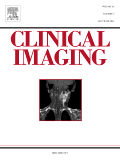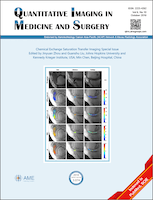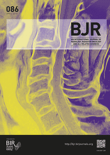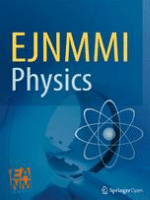
Tomography
Scope & Guideline
Fostering collaboration in the realm of medical imaging.
Introduction
Aims and Scopes
- Advanced Imaging Techniques:
The journal emphasizes the development and application of cutting-edge imaging technologies, including MRI, CT, PET, and ultrasound, to improve diagnostic capabilities and treatment planning. - Artificial Intelligence and Machine Learning:
A significant focus is on the integration of AI and machine learning methodologies in imaging, aiming to enhance image analysis, automate diagnostic processes, and improve the accuracy of interpretations. - Clinical Applications and Case Studies:
'Tomography' publishes research that explores the practical applications of imaging techniques in clinical settings, including case series and systematic reviews that assess the effectiveness of imaging in diagnosing various conditions. - Quantitative Imaging and Radiomics:
The journal promotes research on quantitative imaging metrics and radiomics, investigating how these approaches can provide deeper insights into disease processes and improve prognostic accuracy. - Interdisciplinary Research:
The journal encourages interdisciplinary studies that combine radiology with other fields such as oncology, cardiology, neurology, and emergency medicine, highlighting the diverse applications of imaging in healthcare.
Trending and Emerging
- Deep Learning and Image Reconstruction:
Recent papers increasingly focus on the application of deep learning techniques for image reconstruction, enhancement, and analysis, showcasing the potential of AI to improve imaging quality and diagnostic accuracy. - Interventional Imaging Techniques:
Emerging research explores the role of imaging in guiding interventional procedures, highlighting the importance of real-time imaging in enhancing the safety and effectiveness of minimally invasive surgeries. - Radiomics and Imaging Biomarkers:
There is a growing interest in the use of radiomics and imaging biomarkers to predict treatment responses and outcomes in various cancers, emphasizing the role of imaging data in personalized medicine. - Integration of Imaging with Omics Data:
Studies that integrate imaging data with genomic and proteomic information are on the rise, reflecting a trend towards holistic approaches in understanding disease mechanisms and treatment responses. - Telemedicine and Remote Imaging:
The pandemic has accelerated research into telemedicine and remote imaging solutions, with papers focusing on the efficacy and implementation of imaging services in a virtual healthcare environment.
Declining or Waning
- Traditional Imaging Techniques:
There is a noticeable decline in publications focused on conventional imaging methods without integration of advanced technology or innovative approaches, indicating a shift towards more advanced imaging modalities. - Basic Imaging Methodologies:
Studies that purely describe basic imaging techniques or methodologies without new insights or applications are less frequently published, as the journal increasingly prioritizes innovative and applied research. - Non-Quantitative Analyses:
Research that does not employ quantitative measures or advanced analytical techniques is becoming less common, reflecting a growing emphasis on data-driven approaches and statistical rigor in imaging research. - Single-Modality Studies:
Publications focusing solely on a single imaging modality are waning, as there is a trend towards multi-modal imaging studies that provide a more comprehensive view of patient conditions. - Historical Reviews and Perspectives:
There is a decrease in the number of papers that provide historical reviews or perspectives on imaging practices without a clear application to current research or clinical practices.
Similar Journals

Clinical Imaging
Exploring New Frontiers in Clinical ImagingClinical Imaging, published by Elsevier Science Inc, is a renowned journal dedicated to the field of radiology, nuclear medicine, and imaging. With an ISSN of 0899-7071 and an E-ISSN of 1873-4499, this esteemed publication has established its significance in advancing imaging science since its inception in 1989 and continues to make impactful contributions to the discipline through 2024. The journal holds a prestigious Q2 ranking in the category of Radiology, Nuclear Medicine, and Imaging, reflecting its critical role in bridging research and clinical practice. Currently ranked #113 out of 333 by Scopus, with a notable 66th percentile, it offers a platform for disseminating high-quality research, reviews, and case studies that inspire innovation and enhance imaging techniques. Although it primarily functions as a subscription-based journal, it remains dedicated to accessibility and the dissemination of pivotal findings that inform both academia and clinical settings. Clinical Imaging is essential for researchers, professionals, and students alike, offering insights that shape the future of diagnostic imaging.

Journal of Medical Imaging
Transforming Healthcare Through Cutting-Edge Imaging ResearchThe Journal of Medical Imaging, published by SPIE-SOC PHOTO-OPTICAL INSTRUMENTATION ENGINEERS, is an esteemed publication in the field of medical imaging, playing a pivotal role in advancing the discipline since its inception in 2014. With an ISSN of 2329-4302 and an E-ISSN of 2329-4310, this journal has garnered significant recognition, evidenced by its Q2 ranking in 2023 within the critical category of Radiology, Nuclear Medicine, and Imaging. The journal is dedicated to presenting cutting-edge research and innovations that enhance diagnostic imaging techniques and methodologies, appealing to a diverse audience of researchers, professionals, and students alike. Offering valuable insights into the interplay of optics and imaging technologies, it serves as a crucial resource for fostering knowledge and collaboration in the medical community. Notably, it holds a competitive rank of #136 out of 333 in its Scopus category, placing it in the 59th percentile—a testament to its influence and relevance in ongoing medical research. Therefore, the Journal of Medical Imaging stands out as an essential platform for disseminating transformative findings and innovations in healthcare imaging.

Imaging
Exploring the Future of Radiology and UltrasoundImaging, published by AKADEMIAI KIADO ZRT, is an esteemed open-access journal dedicated to the field of medical imaging, established in 2020. With an E-ISSN of 2732-0960 and based in Budapest, Hungary, this journal provides a vital platform for the dissemination of cutting-edge research and advancements in imaging techniques, especially in the realms of radiology, nuclear medicine, and ultrasound technology. While currently positioned in the Q4 category across multiple medical specialties, the journal continues to strive for improvements in visibility and impact, contributing to the evolving discourse in medical imaging. The journal aims to facilitate an inclusive and collaborative environment for researchers, professionals, and students, inviting them to share their findings and insights to enhance the field's development. With open-access availability since its inception, Imaging ensures free and easy access to its content, fostering a greater understanding and appreciation of innovative imaging practices worldwide.

Current Medical Imaging
Bridging Technology and Patient Care in ImagingCurrent Medical Imaging is a reputable journal published by Bentham Science Publishers, specializing in the dynamic field of medical imaging, with a strong emphasis on both clinical applications and technological advancements. Established in 2007, the journal has made significant contributions to the fields of Internal Medicine and Radiology, consistently ranking in the Q3 quartile for these categories as of 2023. The journal's ISSN 1573-4056 and E-ISSN 1875-6603 ensure wide accessibility for scholarly communication, although it operates under a traditional access model. With its continuous publication from 2011 to 2024, Current Medical Imaging aims to bridge the gap between advanced imaging techniques and their practical application in patient care, making it indispensable for researchers, healthcare professionals, and students eager to stay at the forefront of innovations in imaging technology and clinical practice.

PET Clinics
Illuminating the Path of Medical Imaging Advancements.PET Clinics, published by Elsevier Inc, is a premier academic journal focusing on the advancements and applications of Positron Emission Tomography (PET) in various medical fields. With its ISSN 1556-8598 and E-ISSN 1559-7814, the journal has established a strong reputation in the scientific community, reflected in its impressive Q1 quartile rankings in Medicine (miscellaneous), Radiation, and Radiology, Nuclear Medicine, and Imaging for 2023. The journal operates within a well-defined scope that bridges innovative research and practical clinical applications, targeting professionals, researchers, and students keen on the intersection of nuclear medicine and imaging technologies. Although not an open-access journal, PET Clinics ensures accessibility through institutional subscriptions, making valuable insights available to the academic community. With an emphasis on enhancing patient care and treatment outcomes through cutting-edge imaging techniques, this journal serves as an essential resource for those seeking to expand their knowledge and expertise in the rapidly evolving field of PET.

Hong Kong Journal of Radiology
Connecting Minds, Advancing Radiology KnowledgeHong Kong Journal of Radiology, an esteemed publication of the Hong Kong Academy of Medicine Press, serves as a vital platform for disseminating innovative research in the field of radiology, nuclear medicine, and imaging. Established in 2011 and operating under an Open Access model since 2018, this journal not only promotes the sharing of knowledge but also enhances global accessibility to cutting-edge studies. With its ISSN 2223-6619 and E-ISSN 2307-4620, the journal strives to engage a diverse audience ranging from experienced professionals to aspiring scholars in the medical imaging domain. Despite its current ranking in the Q4 quartile of the Scopus category for radiology, the journal is committed to improving its standing by featuring high-quality research that addresses pressing issues in the field. The journal's convergence from 2011 to 2024 reflects its ongoing dedication to fostering academic excellence and encouraging collaborative discourse among researchers and practitioners globally. Located in Hong Kong, the journal plays a significant role in shaping the future of radiology education and practice in China and beyond.

EUROPEAN RADIOLOGY
Shaping the Future of Medical ImagingEUROPEAN RADIOLOGY, published by SPRINGER, stands as a prestigious international journal in the field of radiology, nuclear medicine, and imaging, with an impressive impact factor that underscores its significance among peers. With an ISSN of 0938-7994 and an E-ISSN of 1432-1084, this journal provides a platform for cutting-edge research and advancements in medical imaging from 1991 to 2024. Recognized as a Q1 journal in both general Medicine and the specialized Radiology category by 2023, EUROPEAN RADIOLOGY ranks an impressive #17 out of 333 in its field according to Scopus, placing it in the 95th percentile. While it does not currently offer Open Access options, the journal remains essential reading for researchers, professionals, and students striving to stay at the forefront of developments in diagnostic imaging and related technologies. By contributing to a comprehensive understanding of radiological practices, EUROPEAN RADIOLOGY plays a crucial role in shaping the future of medical diagnosis and patient care.

Quantitative Imaging in Medicine and Surgery
Transforming Healthcare Through Cutting-edge Imaging TechniquesQuantitative Imaging in Medicine and Surgery is an esteemed journal dedicated to advancing the field of medical imaging through rigorous research and innovative methodologies. Published by AME PUBLISHING COMPANY in China, this journal has established itself with an impressive Q2 quartile ranking in the field of Radiology, Nuclear Medicine, and Imaging, reflecting its dedication to high-quality research. With a comprehensive focus on quantitative imaging techniques, the journal covers a wide range of topics including image analysis, imaging biomarkers, and the integration of imaging in clinical practice, promoting collaboration between imaging specialists and clinicians. As an open access journal, Quantitative Imaging in Medicine and Surgery ensures that its articles are freely accessible, facilitating the dissemination of knowledge to a broader audience. With a commitment to fostering innovation in imaging science, this journal serves as an invaluable resource for researchers, professionals, and students alike, ultimately aiming to improve patient outcomes through advanced imaging strategies and technologies.

BRITISH JOURNAL OF RADIOLOGY
Advancing Radiology Through Innovation and ExcellenceBritish Journal of Radiology is a leading peer-reviewed journal published by the British Institute of Radiology, dedicated to advancing the field of radiology, nuclear medicine, and imaging. With a prestigious history dating back to 1945, this journal is at the forefront of disseminating cutting-edge research and innovations that significantly impact clinical practice. Currently enjoying a Q1 ranking in the field of radiology and Q2 in general medicine for 2023, it is recognized for its rigorous standards and high-quality content, ranking #87 out of 333 in Scopus for specialties related to Medicine, Radiology, Nuclear Medicine, and Imaging, placing it in the 74th percentile. Researchers, professionals, and students are encouraged to engage with the latest findings and comprehensive reviews presented within its pages, which contribute not only to academic discourse but also to the evolution of practice in the wider medical community.

EJNMMI Physics
Pioneering Research in Radiology and Nuclear Medicine.EJNMMI Physics, the premier journal for advancements in nuclear medicine and imaging, is published by Springer in Switzerland and has been an open-access outlet since 2014, allowing for broad dissemination of critical research findings. With an ISSN of 2197-7364, the journal aims to bridge the gap between state-of-the-art physics and practical applications in biomedical engineering and radiology. Its impressive Q1 ranking in multiple categories, including Biomedical Engineering, Instrumentation, Radiation, and Radiology, Nuclear Medicine and Imaging, exemplifies its significant impact in the field. The journal boasts exceptional metrics with Scopus rankings placing it in the top echelons across disciplines, including a 6th position out of 58 in Radiation, and serves as an essential resource for researchers, professionals, and students who are eager to contribute to and stay informed about cutting-edge scientific advancements. With a broadening scope until 2024, EJNMMI Physics is an indispensable tool for those dedicated to pushing the boundaries of knowledge in medical physics and imaging technologies.